Howard Andrew Jones's Blog, page 51
November 28, 2014
Lord Dunsany: A Dreamer’s Tales Wrap Up
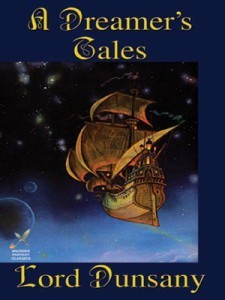 This Friday brings us the final installment of our read through of a Lord Dunsany short story collection, A Dreamer’s Tales. My friends Bill Ward and C.S.E. Cooney have joined me once again to share thoughts and look back on what we’ve read. Unfortunately, Claire was fending off a horde of Gibbelins this week, and had only time to drop by for a few moments.
This Friday brings us the final installment of our read through of a Lord Dunsany short story collection, A Dreamer’s Tales. My friends Bill Ward and C.S.E. Cooney have joined me once again to share thoughts and look back on what we’ve read. Unfortunately, Claire was fending off a horde of Gibbelins this week, and had only time to drop by for a few moments.
Howard: I think the two of you have convinced me that both “The Field” and “Where The Tides Ebb and Flow are” deserving of stars.
But my absolute favorites, stars are no, remain “Blagdaross,” “Idle Days on the Yann,” “The Sword and the Idol,” and “The Unhappy Body.”
Where do you stand?
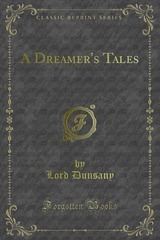 Bill: I’d say my favorites were “Poltarnees,” “Blagdaross,” and “Idle Days,” with quite a few more I really enjoyed but wouldn’t rate as being quite as memorable as those three were for me. “Idle Days” was probably, in retrospect, the standout of the collection, and I’d go back now perhaps and give it 3 stars.
Bill: I’d say my favorites were “Poltarnees,” “Blagdaross,” and “Idle Days,” with quite a few more I really enjoyed but wouldn’t rate as being quite as memorable as those three were for me. “Idle Days” was probably, in retrospect, the standout of the collection, and I’d go back now perhaps and give it 3 stars.
I have not read much Dunsany at all, but what I have read in various Lin Carter collections was overwhelmingly of the ‘secondary world’ sort, of which “Poltarnees” would be a good example. So I was surprised to see Dunsany writing stories with an almost weird tales sort of vibe, and I did really enjoy them, but I think his best work is still in the mold of the mythic fantasy. It’s no coincidence the guy lived in a castle and wrote with a quill pen, after all.
Also, I found this, which I rather like.
Howard: Bill, that music’s kind of cool! Who would have thought to discover music based on “Idle Days on the Yann?”
Claire: I, too, liked “Blagdaross” and “Yann” best. But “The Field” comes a close second, and I don’t think either of you liked that one as much as I did!
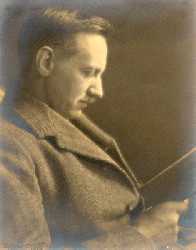
Lord Dunsany
Howard: The further you go into Lord Dunsany’s work the more it becomes about the real world, with occasional moments in a secondary that’s close at hand. The earlier stuff is more secondary, and if we go forward with another collection I’d suggest we start with his second book. I find that his first is one of his most difficult.
Bill, I think you’re right about “Idle Days” being perhaps the greatest tale in the book. He wrote two sequels in one of the even later books and I’m tempted to suggest that we look briefly at those before we start with the book Time and the Gods.
Apparently Borges thought Yann was excellent as well, so we’re apparently in good critical company.
Bill: I like the idea of reading the two “Yann” sequels, and then digging into Time and the Gods, which I believe is the collection I’ve read the most stories from.
I think it’s odd Lord Dunsany grew away from the “deep genre” stuff over time, apparently he was more widely known as a playwright in his lifetime than a fantasist.
Howard: Alright then, let’s spend two more weeks upon the Yann. Here’s a link to the Gutenberg edition of Tales of Three Hemispheres, one of Lord Dunsany’s later (and to my mind weaker) collections. Towards the very end of the collection are “Idle Days on the Yann,” “A Shop in Go-By Street,” and “The Avenger Of Perdóndaris.” I’ve read “Go-By” at some point, but “The Avenger will be new to me.
Let’s just read one next week, “A Shop in Go-By Street.” Hope to see some of the rest of you here!
November 24, 2014
Hardboiled Monday
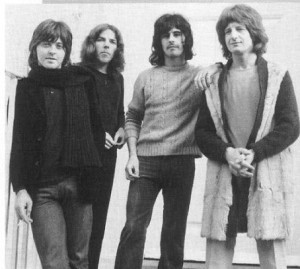 Hardboiled Monday will return next week.
Hardboiled Monday will return next week.
For now, here is “Icicles,” a great and little known cut from Badfinger, off of their fourth album.
November 21, 2014
Lord Dunsany Re-Read: A Dreamer’s Tales, Part 5
 This Friday brings us the fifth installment of our read through of a Lord Dunsany short story collection, A Dreamer’s Tales. My friends Bill Ward and C.S.E. Cooney have joined me once again to share thoughts. You can join in too — this book’s stories not only are quite short, they’re freely available as a Kindle download or through Project Gutenberg. It won’t take very long to catch up if you haven’t read them yet, so you might want to do so before you read any further.
This Friday brings us the fifth installment of our read through of a Lord Dunsany short story collection, A Dreamer’s Tales. My friends Bill Ward and C.S.E. Cooney have joined me once again to share thoughts. You can join in too — this book’s stories not only are quite short, they’re freely available as a Kindle download or through Project Gutenberg. It won’t take very long to catch up if you haven’t read them yet, so you might want to do so before you read any further.
This week we tackled the three final stories of the collection, “The Field,” “The Day of the Poll,” and “The Unhappy Body.” We have a pretty simple review scale. One star is a standout and two stars is truly great.
My favorite this time is “The Unhappy Body.” Though it is dark and sad, I find it holds great power even upon revisitation, and I award it a star. Given that Bill and Claire quote most of my favorite bits below, I’ll forego quotations this time myself.I’m torn about “The Field.” In some ways this one reminds me of a good Twilight Zone episode with a sting at the end you don’t see coming. It’s hard, of course, to enjoy the episode again once you’ve already been stung, and I found on revisiting that it seemed a trifle long even as short as it was… although was that simply because I KNEW how it was going to end? I’m not sure I can evaluate it fairly, now.
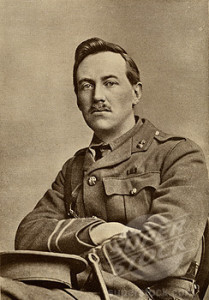 I don’t have particularly strong feelings about “The Day of the Poll” except that I found the narrator’s friend, the poet, more irritating than delightful. The story’s a good sendup of political troubles and all politicians, surely, with some pretty astute observations, but it rubbed me the wrong way because I feel so strongly that every person should vote. I kind of wanted karate chop the poet so the voter could go express his opinion.
I don’t have particularly strong feelings about “The Day of the Poll” except that I found the narrator’s friend, the poet, more irritating than delightful. The story’s a good sendup of political troubles and all politicians, surely, with some pretty astute observations, but it rubbed me the wrong way because I feel so strongly that every person should vote. I kind of wanted karate chop the poet so the voter could go express his opinion.
Bill, what was your take?
Bill: “The Field” *: Arthur C. Clarke’s Childhood’s End first acquainted me with the notion that the future could somehow resonate within the present and past — in that book, which I won’t spoil the surprise of, there was something so traumatic to the human race that it rebounded into the past to influence our collective subconscious. Clarke said something about quantum theory to prop up this this very poetic idea, but Dunsany goes straight to the heart of it when it is only a poet that can discern just what the narrator of “The Field” finds so unsettling about a particular spot of ground just outside London. We are told nothing of significance has ever happened in this quiet spot, and so, when in the last line of the tale the poet identifies the place as a battlefield, we know that the horrors of that war are still to come. It gets a star for the cool idea and the execution, though I agree it felt a bit long.
“The Day of the Poll”: Again we have the poet as a man apart, someone aloof from common concerns. When the entire town “went mad” with election fever, the poet removes one townsmen from that environment and shows him some of the beauty in the world outside of the beehive of human society. Politics is portrayed as petty, a herd instinct, the losing candidate’s failure a foregone conclusion because he “had neglected to subscribe to a single football club.” I can well imagine the hypothetical criticism of aristocratic Dunsany scoffing at the lower classes, but that’s a failure to understand what he’s saying. We all get wrapped up in such concerns to varying or lesser degrees, but few people have the perspective to put them in proper context for long. I have to say I can relate to Dunsany’s poet when I see people so eager to separate themselves into partisan ranks, or so consumed with some sort of group identity. I’m with you, Howard, in believing everyone should vote, and that thought does diminish the story for me somewhat, but I don’t see how this premise for a story would make sense if it was a non-political activity, either. I certainly don’t read it as anti-political though.
 “The Unhappy Body” *: The dialog between body and soul in this story is reminiscent of that between the soul of the suicide and the rope in “Blagdaross.” This soul is “tyrannous,” full of dreaming and an urge to dream, and to write those dreams. Was Dunsany ever so weary as this? Certainly he understood the urge that drives the artist, the soul that seems a separate thing and hungers after work for which there “is no reward.” In the end, the body does get its eternal rest, and the soul is off to dream some more. I think the sadness is tinged with a bit of a tongue and cheek self-awareness, I feel as if Dunsany would have agreed with the soul’s outrageous demands and that the body should know its place. The soul getting what it wants, right up to the last minute when the body finally calls quits, seems like the victory of a life well-lived.
“The Unhappy Body” *: The dialog between body and soul in this story is reminiscent of that between the soul of the suicide and the rope in “Blagdaross.” This soul is “tyrannous,” full of dreaming and an urge to dream, and to write those dreams. Was Dunsany ever so weary as this? Certainly he understood the urge that drives the artist, the soul that seems a separate thing and hungers after work for which there “is no reward.” In the end, the body does get its eternal rest, and the soul is off to dream some more. I think the sadness is tinged with a bit of a tongue and cheek self-awareness, I feel as if Dunsany would have agreed with the soul’s outrageous demands and that the body should know its place. The soul getting what it wants, right up to the last minute when the body finally calls quits, seems like the victory of a life well-lived.
Claire, what did you think of these three?
Claire: I give “The Field” a star too, first because “upland behind upland in the twilight” gave me a thrill in the first paragraph; second, because the phrase “long ago, when the elf-kings still had horns” made me want to write at least THREE NOVELS; third, because suddenly all the pretty fairy mists and hills turned into a creeping nightmare, and HOW DID HE DO THAT?; fourth, because the slamming shut of the book, or the abrupt awakening from that nightmare at the end, gave me an adrenalin jolt equivalent to that time when my little brother was watching the movie “Arachnophobia” and I crept up behind him and tickled the back of his neck, and he jumped about six feet. That was so great. So was the effect of Dunsany’s last line. Since it was my first time reading “The Field” I cannot speak to Howard’s complaint that the second time through the story loses its punch and dazzle, but it was my first time, and I’m basking in a sense of awed admiration. And that’s okay, I think.
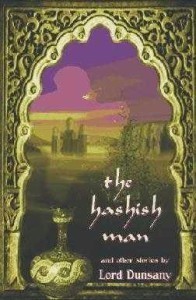 “The Day of the Poll…” Meh. I liked that in the midst of the sad poet’s pretty reflections the whole town was raving mad. But this story was more about matters of taste than truth, and when a story is about taste, I like it to be fair. I like to see both sides, and judge them by their behavior, and get to decide for myself who or who is not raving mad. Those stories are best when I finish them upset and ambiguous. This one was so judgmental. Poetry is good; politics are bad. But one could easily rewrite this story from a reformer’s perspective, in which the narrator is one of your mild-eyed, soft-spoken kidnapping-and-brainwashing types. Great changes are happening in the country, and this wispy dude just removed a crucial voter to study thorn bushes and reminisce about ages past. What the heck? Anyway. It kind of infuriated me. That is, if I could bring myself to care enough to feel fury, which is less what happened upon reading the story and more what is happening now, reflecting upon it.
“The Day of the Poll…” Meh. I liked that in the midst of the sad poet’s pretty reflections the whole town was raving mad. But this story was more about matters of taste than truth, and when a story is about taste, I like it to be fair. I like to see both sides, and judge them by their behavior, and get to decide for myself who or who is not raving mad. Those stories are best when I finish them upset and ambiguous. This one was so judgmental. Poetry is good; politics are bad. But one could easily rewrite this story from a reformer’s perspective, in which the narrator is one of your mild-eyed, soft-spoken kidnapping-and-brainwashing types. Great changes are happening in the country, and this wispy dude just removed a crucial voter to study thorn bushes and reminisce about ages past. What the heck? Anyway. It kind of infuriated me. That is, if I could bring myself to care enough to feel fury, which is less what happened upon reading the story and more what is happening now, reflecting upon it.
“The Unhappy Body.” I’m sure you gentlemen noticed that this is the last story of the book. Don’t you find that significant? Especially given the nature of the story, and the plaintive tranquility in the last line. I love what Bill said, “Was Dunsany ever so weary as this?” I love that. It is as if the author has exhausted himself giving us “A Dreamer’s Tales” and now death would be preferable to any such further endeavor. I’m not much for the, hmn, whining nature of the story, but it has that great paragraph wherein the Body says, “I am united with a fierce and violent soul, that is altogether tyrannous and will not let me rest, and he drags me away from the dances of my kin to make me toil at his detestable work…” It goes on from there. It is MAGNIFICENT. It was my first Facebook update of the day. I like the thought that this was as much a tongue-in-cheek self-reflection as it was a lamentation from the bowels of the author’s being, but I had trouble seeing the humor in it, if it was there. But then, I was never very sharp on the uptake where satire was concerned. It was a great choice to end a collection with; for that, and for the righteous artist’s monologue, A STAR.
Howard: That’s all for this week, and the end of the book. Next week we’ll look back and discuss our favorites and decide whether or not we wish to continue on.
November 17, 2014
Hardboiled Monday: The Last Good Kiss
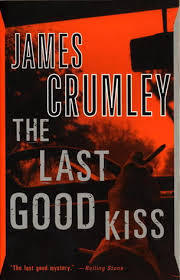 As with preceding Hardboiled Mondays, Chris Hocking and I are working our way down the master list in alphabetical order. Details and the list are here. And earlier discussions are here.
As with preceding Hardboiled Mondays, Chris Hocking and I are working our way down the master list in alphabetical order. Details and the list are here. And earlier discussions are here.
Today we’re looking at James Crumley’s The Last Good Kiss.
Chris: Back when I worked in a bookstore James Crumley was hard to shelve. The author’s first book, One to Count Cadence, came out in 1969 and was a critically acclaimed novel about US servicemen in Vietnam and the Philippines. At that time it was a Vintage Contemporary paperback and shared that influential line of modern fiction’s packaging and cover design with, for example, Jay McInerney’s Bright Lights, Big City and Cormac McCarthy’s Suttree. Had to shelve those, and One to Count Cadence, in Fiction, but Crumley’s other work, The Wrong Case, The Last Good Kiss and others, were pretty clearly Mystery.
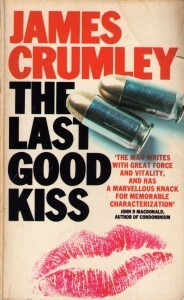 In a big bookstore you have to try to shelve books where a customer will think to look for them, so we split Crumley’s work between Fiction and Mystery, having copies in both places whenever we had enough books.
In a big bookstore you have to try to shelve books where a customer will think to look for them, so we split Crumley’s work between Fiction and Mystery, having copies in both places whenever we had enough books.
These days The Last Good Kiss is packaged as nothing but a mystery, and it fits the genre as well as a you could ask. It has the classic hardboiled sense of characters trying to find the truth, trying to determine the right thing to do and then do it, but this is made even more challenging than usual by a fog of Vietnam era disillusion and a desperate dependence on alcohol.
Howard: It’s appropriate you should mention alcohol, because I think it turns up more here than in any other book on the list except Latimer’s The Lady in the Morgue (or in some Hammet, who may not have been aware that liquor’s prevalence had a statement). Most of Crumley’s characters are constantly drinking, are preparing a drink, or on their way to get a drink. Their dependance upon alcohol is just one of the most obvious symptoms of their underlying issues.
I’ve been wondering what I’d say about this one for a long time. It’s hauntingly beautiful. It’s darkly tragic, seeded with moments of comedy. I’m not sure I’m yet willing to call it a masterpiece — if it lingers in my memory (in a good way — not in a “Batman Forever was so bad I can never erase certain moments” way) over the next few years perhaps then I will go that far.
That said, I do not feel compelled to re-read the book, as I do with key works of both Chandler and Richard Stark. I’m not entirely sure why except that its darkness is deeply affecting, and knowing now how the mystery all comes out it would be all the more painful than experiencing it as the story unfolded. Maybe I’m still too much of a softie for real noir.
Chris: I was going to suggest that Crumley’s fine prose combine with his often intoxicated characters to create a sense of Raymond Chandler filtered through Hunter Thompson, but poking around on the web I see that combination has been used to describe Crumley’s work more than once. I don’t want to make too much of that rather flip assessment, but there is something to it. Here is beautifully polished, melancholy prose depicting the world as seen by characters intent on distorting their apprehension of it, with little thought of their health, their future, or any of the many problems such a lifestyle engenders.
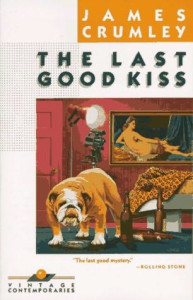 C.W. Sughrue, the hard-drinking thirty-something vet narrator of The Last Good Kiss, takes a job chasing an author on a prolonged binge and finds himself hired to find a girl missing for ten years. This seemingly impossible task grows steadily more alluring the longer Sughrue works at it. The more he learns about her, and the almost pathological effect she’s had on most everyone she spent time with, the more he wants to know, until he is as obsessed with his version of her memory as those he finds who actually knew her.
C.W. Sughrue, the hard-drinking thirty-something vet narrator of The Last Good Kiss, takes a job chasing an author on a prolonged binge and finds himself hired to find a girl missing for ten years. This seemingly impossible task grows steadily more alluring the longer Sughrue works at it. The more he learns about her, and the almost pathological effect she’s had on most everyone she spent time with, the more he wants to know, until he is as obsessed with his version of her memory as those he finds who actually knew her.
It is in the creation of this lost woman and those who remember her that The Last Good Kiss reaches greatness. Lost individuals, lost love and haunted pasts are common in hardboiled fiction, but these elements attain a strange depth and luster here. Betty Sue Flowers, gone missing in ’60s Haight-Ashbury a decade past, can be seen as something of a human mirror. Everyone Sughrue meets wanted her love, but also something more that differs from person to person. Those who come to know her are drawn by her beauty, her skill, her strange charisma, and in her they seem to see what they want most, their best potential fulfilled. When she is gone she leaves behind a sense of dreams betrayed. This is not her fault, and a terrible burden to bear.
Howard: That’s beautifully said. I don’t know that I can add much to that, Chris, except that part of the tragedy is that no one really knows Betty Sue for who she really is, even if they think they do.
Chris: There are several passages in The Last Good Kiss good enough that you might get that rare urge to read them aloud to a friend, even if you have to call that friend long distance to do it. Although very much a novel of detection, with clues, a mystery, and a final harrowing twist, the book is more concerned with character, and its failure, than anything else. It’s a strange, beautiful, and quite uncomfortable novel.
November 13, 2014
Dunsany Friday
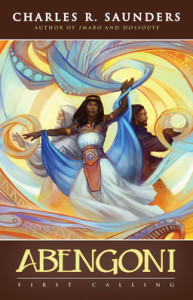 I’ve been dispatched down the river Yann on a secret mission, so our re-read of A Dreamer’s Tales will have to conclude NEXT Friday.
I’ve been dispatched down the river Yann on a secret mission, so our re-read of A Dreamer’s Tales will have to conclude NEXT Friday.
For now, here are two items of interest.
First, one of the greatest sword-and-sorcery writers of the ’70s (and one that by all rights should be a household name) has a new book out. Charles Saunders’ newest novel has been covered in glowing detail by Fletcher Vredenburgh at Black Gate. Go check out the review, and buy the book.
Second, if you’re any kind of fan of Barbarian Prince you need to look into a phone app titled The Road of Kings, which was very clearly inspired by the old board game and is great fun, so long as you keep in mind the game experience it’s trying to emulate. I’ll write a longer review, probably at Black Gate, when I get back from my sojourn on the Yann.
November 12, 2014
The Return of The Barbarian Prince
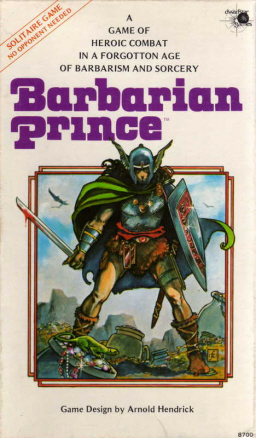 If you’ve spent much time on the Black Gate website you’ve probably seen Barbarian Prince get mentioned at least once.
If you’ve spent much time on the Black Gate website you’ve probably seen Barbarian Prince get mentioned at least once.
A solo board game from the ’80s designed by Arnold Hendrick, Barbarian Prince is a little like one of those old “choose your own” adventure books, except that the order of events is far more random, for they’re generated by rolling on a number of tables depending upon your location on the map and are partly affected by choices you have made and gear and allies you may have accumulated in your travels.
It never plays the same way twice, and a lot of us find it glorious fun — although it is difficult to win. John O’Neill is a huge fan of the game, and he got me interested some years back when he gave me an extra copy he had lying around.
When I heard rumors of an unofficial redesign over at BoardGameGeek, I dropped by to take a look and was incredibly impressed. Someone — Todd Sanders, as it turns out — had gotten permission to create a new game board, pieces, and redesign the layout of the rule and event books.
The result was brilliant, beautiful, and a completely professional product.
It’s available, free, for anyone who wants to download the files and create their own version of the game (the original version of Barbarian Prince is also available for free download, courtesy of Reaper Miniatures and Dwarfstar Games).
I contacted Todd to learn more about his redesign and what had inspired it, and discovered he was responsible for a number of stunning games of his own creation.
We talked about game design, Print and Play games, and, naturally, Barbarian Prince. Larger versions of the lovely game boards can be seen by clicking on their pictures.
Note: This article is reposted from the Black Gate web site, where it appeared in 2012.
An Interview with Todd Sanders
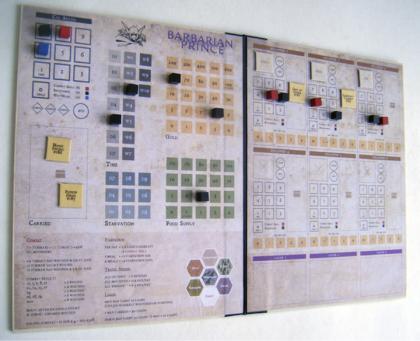
Barbarian Prince tracking sheets, designed by Todd Sanders. Click for bigger version.
HAJ: Let’s talk a little about your own background. Have you always been a gamer? What led to your interest in game design, and how long have you been involved with it?
Todd: About 10 years ago I became interested in game theory and, as a part of that, I started reading about ancient board games, collecting several of RC Bell’s books –- Board and Table Games from Many Civilizations and The Boardgame Book, as well as Sid Sackon’s A Gamut of Games.
I started making my own versions of some of the games in these books, fascinated by how the structure of the games evolved over time and how different cultures used the same kinds of components but games varied so wildly.
This led me to check out one of our local game stores (we are lucky enough to have 2 great ones here in Pittsburgh – Games Unlimited and Phantom of the Attic) and like many have – ended up really finding a great hobby and community.
As to game design, I’ve only been doing that for a little over a year.
I began by creating player aids to games I liked, then started redesigning components (my first was a new board for the game Manhattan).
I started to notice the Print and Play community on BoardGameGeek.com (BGG) would run various design contests and reading those forums got me interested in trying my hand at designing some simple dice games at first, then, later, more complex ones.
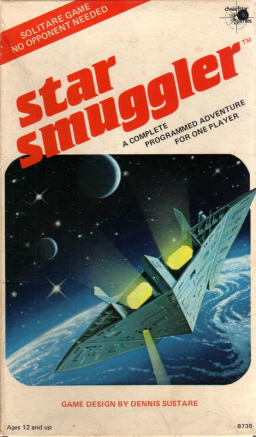
Star Smuggler, another paragraph-based adventure game from Dwarfstar
I am a graphic designer (and have a degree in architecture) so I feel I have skills and an education which taught me about thinking logically through a series of steps and organizing and presenting information.
The work of Mike Doyle, who is an amazing boardgame graphic designer, showed me that I could integrate much of what I was creating visually by day into layouts for games and components.
What do you think it is that people like so much about Barbarian Prince ?
Barbarian Prince I believe appeals to people because of its narrative structure.
A number of games from the early 1980s (many of these produced by Dwarfstar) used what is called a paragraph game mechanic where dice would be randomly rolled causing events to occur, referenced from one or several books (this system has more flexibility than the competing “choose your own adventure” books popular as well at the time).
There are a large number of possible event outcomes and from these a story develops and the game becomes an immersive experience.
These types of games can provide distinctly different narratives each time the game is played. This is all coupled with the fact that BP is a solo game in which scenarios can sometimes take several hours to play – so you get a rich game experience and one you can return to again and again with a different outcome each time.
I think games are often successful due to the “if only” factor – “If only I had done this … I would have won. I need to play again” — This is what makes me, and I suspect many, return to games like Barbarian Prince — the choices we make affect the outcome. Change the choices, alter the outcome.
Why did you decide to redesign the game?
Several designers on BGG inspired me to try my hand at a re-design/reboot.
There are a great number of games from the early 1980s that are rewarding gaming experiences but due to older production methods or scarcity, the games are difficult to find or to play.
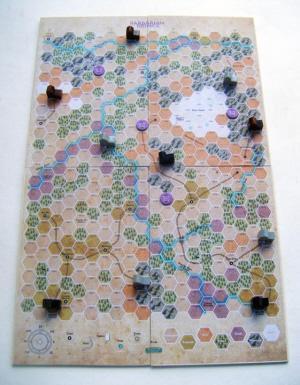
The Barbarian Prince map re-imagined by Todd Sanders. Click for bigger version.
In an era where Fantasy Flight Games and other euro companies are producing high quality, sometimes flashy games with wooden components and fully realized art, sometimes older games are judged unworthy by their visual appearance alone. We do not always take the time to appreciate what is below the surface.
Barbarian Prince has a difficult reputation because the rule and event books can be challenging to use. To borrow a software design term, the user interface prevents players from fully engaging in the experience.
My day job is in large part about creating a visual/textual systems for understanding and expressing information. Whether I am designing a book or a business card or an infographic I am always interested in how I can present information in a clean and easy to understand method so that the intended message can be understood.
So BP seemed a likely candidate for a reboot. Due to Reaper Miniatures licensing agreement with Dwarfstar, the game is available for free to those wishing to print and play it.
I spoke to people involved with the game about any copyright issues and they were very generous in allowing me to work on a redesign.
It was important to me, during the design process, to respect the original artist and designer’s work.
My main focus on the redesign was making the rules and event books easier to navigate so that they weren’t a barrier to playing the game itself. How events are presented and charts and tables designed should not detract from finding the information needed to enjoy the narrative.
The work of information designer Edward Tufte, who I am an admirer of, is a good starting point for anyone wanting to understand how information can be presented.
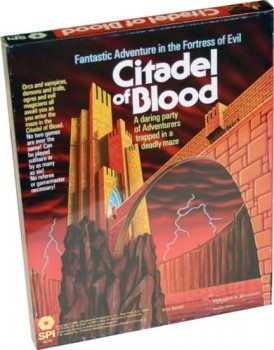 How much time does a typical redesign take you?
How much time does a typical redesign take you?
Barbarian Prince was my first redesign and it took about a month to complete.
I probably spent around 40-50 hours working on the game, redesigning both books, all the tables and charts, and redrawing the map which was a large undertaking.
I am not an artistic illustrator so my work is usually text and icon based and it took time to find the right “feel” for what I wanted to do with the map.
I am very pleased with the final design. It strikes a good balance of art and information for me. It is not a copy by any means of the original but an interpretation.
I am also very grateful to several other boardgamers before me who created errata FAQs and corrected rule sets as well as a BGG users — Jumbit and Julian Jimenez (among others) who created a series of player aids which simplified looking up events.
All work builds on those who come before us.
I am currently at work on my 3rd rebuild, having completed a redesign of Citadel of Blood (SPI), a wonderfully innovative fantasy game from 1980 designed by Eric Lee Smith.
Right now I am redesigning Star Smuggler, another paragraph-based Dwarfstar game. This one has a science fiction theme and lets me try my hand at that genre which has its own rich visual systems.
After that is done … I’ve started looking into another old game – Hammer of Thor, which has a daunting number of cards to design but holds some fascination for me from a mythological standpoint
How has your work been received?
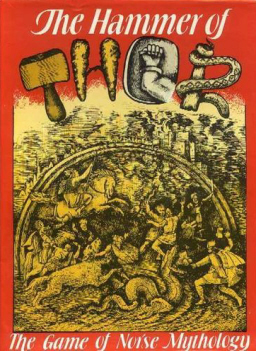 I’ve been overwhelmed by the positive response.
I’ve been overwhelmed by the positive response.
My design, which supports a terrific game, has caused many new players to give the game a try. We reached the top 10 games list on BGG’s Hotness sidebar for a few weeks running and my work was featured on the “hotness” image section of BGG as well for several weeks.
Last week Marco Arnaudo posted a new video review of the game and I was pleased to see my design was the one he was using for his review.
I’d like to make it clear that my work was done to support a game that was already a gem, if undiscovered by many. Credit should go Arnold Hendrick, the designer, and artists Frank Cirocco and Cynthia Sims Millan.
My work may bring gamers to the table but the experience the original design team created is what ultimately people enjoy.
BGG has a great community of creative, supportive people and I am pleased to call a great many of them friends. It would be a dream if what I’ve done might cause a publisher to reprint the game so that new generations could enjoy it.
We are starting to see a revival of older games in new printings – Wiz War and Merchant of Venus to name a couple – I hope there are more.
What do you think explains the rising popularity of Print and Play games? Is there a place where you can meet with fellow game designers and fans and compare ideas and techniques?

Todd’s Citadel of Blood re-design.
Print and Play is a unique subcategory of board games.
Primarily this community is found on BoardGameGeek.com. I’ve mentioned previously that the community runs self-directed contests on all sorts of themes, as well forums on game design, general support and cheerleading and playtesting.
Many designers who win these contests (myself included) have gone on to having our games signed to publishers and have had iOS/Android apps made as well.
I think we feed a desire for interesting games on subjects that big name publishers may not find work with their product lines. We can also take chances and try out new and different mechanics.
Sometimes these work, sometimes not. I think publishers are looking for undiscovered but proven talent and the PnP community affords them the opportunity to gauge the success of games we are creating.
Lastly, the do-it-yourself ethic of actually constructing the games by hand has a lot of appeal to many of us.
Recent design contests have focused on games using only 54 cards, games for solo players, games that use only a single sheet of paper. These design constrains have produced some wonderful games and are relatively easy for beginners to craft.
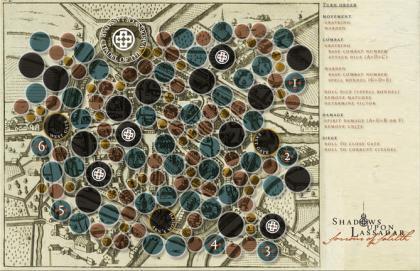
Shadows Upon Lassador: Sorrow of Salith, a game by Todd Sanders. Click for bigger version.
There is a large “maker” community growing in the world, people finding rewarding experiences by creating things again by hand and I feel like we are part of that movement in our own unique way.
Where can people go to find other good Print and Play games, and where can they turn to learn how best to try their hand at printing and playing them?
BoardGameGeek.com is probably the best source.
Print and Play (PnP) games that I, and many others, design are completely free to download.
Often designers will provide low-ink versions for those who do not have access to color printers. There are a wide number of forum discussions as well on how one goes about making decks of cards, creating folding game boards and boxes and finding sources for the game bits you need for the games.
Craft stores are excellent resources for wooden cubes, pawns and such (I have a feeling many scrapbookers are also PnP game makers because of the tools needed).
There also are a growing number of web sites and production houses (Print and Play Productions, The Game Crafter are two) that will print/craft professional copies of games up for you.
And there are two printing companies in Hong Kong a lot of us use because they print professional quality decks of cards that you can order single copies of.
BGG users maintain a large list of PnP games you can order in this way. Many of us spend lavish amounts of time on these builds creating true works of art.
You’ve designed a number of beautiful looking games, many of them original. Can you tell us a little about your inspiration for them?
My games really follow two separate streams of creation. Much of what I design for the PnP community comes out of my life long love of science fiction, fantasy and fairy tales. I’ve created two lengthy game narratives in the last year:
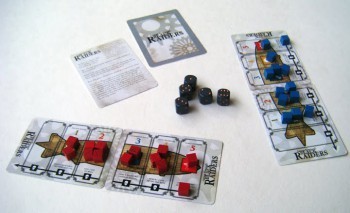
Aether Captains: Dread Supremacy.
The steampunk world of Arkady and a series of games with the umbrella title: Aether Captains.
I’ve designed 8 or 9 games in this world and have extensive written notes, maps, and diagrams to support the designing. I’ve posted much of the background information on BGG and invite anyone to design games using what I’ve created.
If you play all the games you’ll notice I change scales — from focusing on events across the world of Arkady, to small solo games about one person in one of the cities of the Grand Compact and it is great that the narrative I’ve build can allow for that flexibility.
All the games, due to my graphic background, have a clearly thought out idea of branding with carefully chosen fonts, colors and consistent terminology. It is my hope gamers, new to the world, have an easy time learning each new game because of these details.
My other main game narrative involves the fantasy setting of Lassadar, a world where magic can have a corrupting influence, even when used for good.
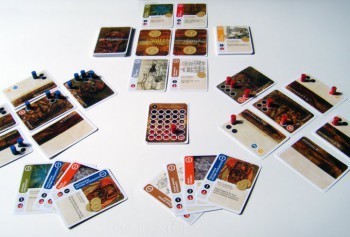
Aether Captains: Capek Golems, a game by Todd Sanders.
I’ve designed a trilogy of solitaire games (each employing different mechanics to provide an opponent for the player to play against) where the Grayking, once a part of the Council of Wardens, was exiled to the Barrier Planes, imprisoned in his Tower of Ash by three Barrier Gates.
He wishes to return to Lassadar and you need to stop him from doing so.
I liked working in the trilogy format for those games, familiar to readers of fantasy. It allowed me to play with some of the genre conventions in my own way and provide a structured narrative format.
Again, for these games, branding was important and all of the artwork, text and visuals support the atmosphere and the world I am building. This can be an organic process, must like writing a novel and I’ve really enjoyed seeing my creations come to life and others really embracing what I am doing.
I also have begun designing games which are for the euro games market. Typically involving short playing times and themes of building and exploring, these are games that I’ve done a lot of reading and research during the design process and have actively tied the theme of the game strongly to the mechanics of play:
Ragnarok: Aesir and Jotunn (a 2-player card game about the Frost Giants and Asgardian Gods) is under contract with a French game publisher.
This game won an award in one of the BGG PnP contests and was a lot of fun to design. I had been reading Norse myths at the time and the game evolved out of what I was reading.
Serica (a 2-player board game about the ancient silk road trade between Rome and China) and Polders ( a 2-4 player board game about reclaiming land from the sea in the Netherlands) are both under review in Europe and will hopefully be signed soon. Both of these games have a historical under current to them and I’ve worked hard to make sure that the people, places and structures in the games are historically accurate.
Where can your games be found or ordered?
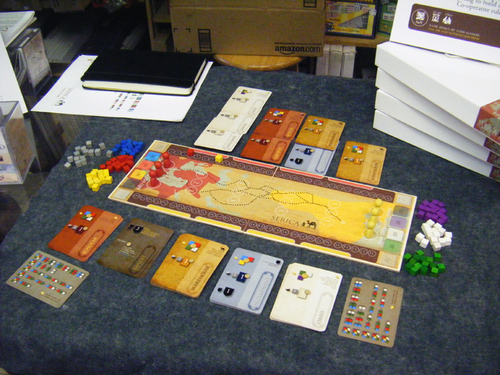
I have handmade copies of many of my games for sale and, because I build them myself, I can only offer small quantities at a time.
I like to call them artisanal editions. All the cards are professionally printed and I include all the dice and wooden cubes needed to play.
The game boards for Sercia are mounted on modeller’s plywood that I cut in my own woodshop.
I have copies for sale through one of my local game stores — Games Unlimited — and they can be ordered through them. Please note that there is a lead time of about a six weeks due to me not being a factory.
Another option for those looking to order is Andrew Tullsen of Print and Play Productions. Andrew prints and assembles many different PnP games from a lot of great designers.
Currently I am working on a solo RPG campaign style game which is done completely in a card deck format (not a CCG or LCG though).
It builds on what I’ve learned redesigning these older paragraph type games as well as my Lassadar trilogy. It is a long term project mainly because I am enjoying getting caught up on the last 30 years of developments in the RPG community.
I am also working on a card game for 2-4 players about Uruk, the first true city of the world, where the different types of cards are played and scored in ways depending on which cards they are played in conjunction with.
I am trying to develop a symbiosis between the types of cards so it is a bit of a Civ-building game mixed in there with strategic choices.
And I’d like to return to the world of Aether Captains that I created over the past year designing some new games for that. These days I carry a notebook around with me for when inspiration strikes.
I like to design games that tell a story, where the narrative and theme are directly intertwined with the mechanics and strategy, hopefully creating a rich experience for the player or players.
It is important to me to continue to develop solo games which I think is a segment of the market publishers are only now beginning to address.
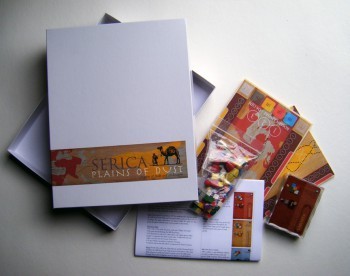
The Serica game, rules, pieces and box.
Do you still have time to actually play the games? What are your favorites, first of your own, then of others.
I have time to play a great number of games as well as constantly read rule books. An important part of designing games is understanding how games work, how the concepts of decisions trees, forced scarcity, prisoner’s dilemma (to name a few) interconnect and create the game structure. In order to learn you need to play a lot.
Of my own games I think I am really most partial to Serica, a game I really put everything I’ve learned over the past year into.
Aether Captains: Triad includes 3 mini games using 54 cards and the same set of components, something I am proud of as well and never pass up a chance to play.
I also like playing a solo game called Bibliogamo I designed which is about creating books in a medieval city. Probably though if, I am honest, it is always the next game I am designing that I am most excited about.
My current favorite published games include 7 Wonders, Glen More, Thebes, Notre Dame, Princes of Florence, and Race for the Galaxy, many of which I can play solo.
I have to mention also some great PnP games out there: Jasper and Zot, Chunky Fighters, RoboDerby: Express, Plantation, and Decktet, which can be printed for free.
Todd, thanks for taking the time to answer in such detail. It was a pleasure having you here. Best of luck with all of your gaming endeavors.
Here’s a master list of all the games Todd has designed, with dozens upon dozens of lovely pictures. If you want to see what Todd’s working on now, and how he’s gone about creating many of his games, his forum posts make for interesting reading for anyone even remotely interested in game design and theory.
If you’re interested in trying out Todd Sanders’ Print and Play re-design version of Barbarian Prince, visit the Barbarian Prince page over at BoardGameGeek and scroll down to the file section on the main page. Download the files and have at it! As for instructions on print and play, there are some fine suggestions right here. The original version of Barbarian Prince can be found at the Dwarfstar Games web site.
Inspired by Todd’s beautiful work I decided to build a Print and Play version myself. I’ve been hampered a bit by my limited craft skills, but I got one up and running, and have been playing the game with my son. I’ll tell you about the whole experience in a post next week.
November 10, 2014
Howard Jones and Mark Rigney at the Evansville North Library
Hardboiled Monday is temporarily on hold today so I can get all nearby reader attention to come to the Evansville, IN North Park Library on Wed. Nov. 12th!
My good friend and fellow writer Mark Rigney will be holding forth with me starting at 6:30, talking about all things books: craft, genres, publishing, the whole enchilada. Yes, we’ll have books to purchase, but the emphasis will be on a seminar-style chat. Questions will be welcome! And YOU, yes YOU, are welcome to attend!
November 7, 2014
Lord Dunsany Re-Read: A Dreamer’s Tales, Part 4
 This Friday brings us the fourth installment of our read through of a Lord Dunsany short story collection, A Dreamer’s Tales. My friends Bill Ward and C.S.E. Cooney have joined me once again to share thoughts. You can join in too — this book’s stories not only are quite short, they’re freely available as a Kindle download or through Project Gutenberg. It won’t take very long to catch up if you haven’t read them yet, so you might want to do so before you read any further.
This Friday brings us the fourth installment of our read through of a Lord Dunsany short story collection, A Dreamer’s Tales. My friends Bill Ward and C.S.E. Cooney have joined me once again to share thoughts. You can join in too — this book’s stories not only are quite short, they’re freely available as a Kindle download or through Project Gutenberg. It won’t take very long to catch up if you haven’t read them yet, so you might want to do so before you read any further.
This week we tackled only two stories, “Carcassonne” and “In Zaccarath.” We have a pretty simple review scale. One star is a standout and two stars is truly great.
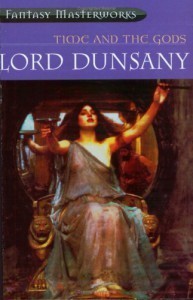 In some ways it may seem that Dunsany has shown us all the themes he’s capable of covering. He hasn’t, it’s just that if THIS is the first book of his you’ve read, you’ve run into some of the same things several times.
In some ways it may seem that Dunsany has shown us all the themes he’s capable of covering. He hasn’t, it’s just that if THIS is the first book of his you’ve read, you’ve run into some of the same things several times.
“In Zaccarath” gives us another city doomed to die, complete with splendid descriptions of the court in its full bloom and what little is left after time and tide has swept on. As Bill mentioned last week I’m comparing Lord Dunsany only against himself, but it’s hard for me to know how I would have felt about “In Zaccarath” if I’d read it before, say, “Bethmoora” or “The Madness of Andelsprutz.” I think I’d still prefer “Andelsprutz” over “Zaccarath,” followed by “Bethmoora.” Zaccarath is slightly different in that it feels that the focus is upon the folly of the king and his court rather than upon the city itself — so secure in their power that they ignore all the signs and portents that the end has come. That I like, as well as all the jeweled imagery and the length, which is dead-on. But I’m still not sure I’d give it a star.
I have mixed feelings about “Carcassonne” as well. I want to like it more than I do. There are so many fine phrases, like the description of the palace, or of the ageless and beautiful witch in her bath of endless waters. There are tremendously quotable lines, like “We must wrestle with Time for some seven decades, and he is a weak and puny antagonist for the first three bouts.” And then there are the spiders, who are to be surprised when the knights don’t return, leaving the hall for their webs.
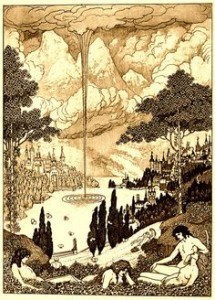 For these and for the marvelous scene of the dragon playing with a bear like a cat with a mouse and several other moments I feel like I should give it two stars, but then I compare it to my very favorites from earlier weeks and it seems too simple a theme stretched on too long for too obvious an end. And I think how much I wish to return and re-read the others I’ve given two stars — I know I’ll re-read “Idle Days on the Yann” whereas I’m not sure I’ll feel the need to go back to “Carcasonne again.” So, one star, despite all that beautiful imagery and wonderful phrasing.
For these and for the marvelous scene of the dragon playing with a bear like a cat with a mouse and several other moments I feel like I should give it two stars, but then I compare it to my very favorites from earlier weeks and it seems too simple a theme stretched on too long for too obvious an end. And I think how much I wish to return and re-read the others I’ve given two stars — I know I’ll re-read “Idle Days on the Yann” whereas I’m not sure I’ll feel the need to go back to “Carcasonne again.” So, one star, despite all that beautiful imagery and wonderful phrasing.
How do you two feel about them?
Bill: Interesting you should mention themes, Howard, I was thinking the same sort of thing about repetition. I do think Time is one of Dunsany’s great themes, though, with all of his lost cities and tales of inevitable collapse and unavoidable fate. I gave both stories one star, I’ll be reading them again, but I felt both fell a bit short of their promise as well.
 “In Zaccarath” * feels like more of a vignette, I think, or at least I was expecting something a little less abrupt for the ending. I love the picture Dunsany paints, a decadent court that can’t even comprehend its own end in the face of repeated warnings. A really fine bunch of Dunsanian names occur at the beginning and the image of a hall so large that clouds pass through it is fine fantasy stuff. The hugeness and scale of the place reinforces the remoteness of its rulers, who, from their lofty position, mishear prophecies of doom as promises of endurance, which I think is a great metaphor. I don’t rate this higher because I think it has the ingredients of a story that could have been a masterpiece, but seemed abrupt or incomplete to me. Or maybe I was just waiting for the doom to fall as part of the narrative.
“In Zaccarath” * feels like more of a vignette, I think, or at least I was expecting something a little less abrupt for the ending. I love the picture Dunsany paints, a decadent court that can’t even comprehend its own end in the face of repeated warnings. A really fine bunch of Dunsanian names occur at the beginning and the image of a hall so large that clouds pass through it is fine fantasy stuff. The hugeness and scale of the place reinforces the remoteness of its rulers, who, from their lofty position, mishear prophecies of doom as promises of endurance, which I think is a great metaphor. I don’t rate this higher because I think it has the ingredients of a story that could have been a masterpiece, but seemed abrupt or incomplete to me. Or maybe I was just waiting for the doom to fall as part of the narrative.
“Carcassone” * is another about inevitability, fate, human powerlessness to confront the march of time. A vigorous troop of heroes led by a young King set out to take a city they are told they can never achieve, and spend the rest of their years at the task. And fail, in the end. Howard, you already pointed out many of the images that stuck with me as well, and this story really does have some jewels. I think the story almost invites an allegorical reading (a journey through the stages of life for example), but I don’t think that’s what Dunsany is doing, and I think the story would be weaker if he had.
So both stories feature human folly in the face of the inevitable, but that human folly is glorious all the same.
Thanks, Bill. Claire, what did you think?
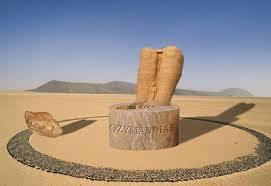 Claire: The first thing out of my mouth when I finished “In Zaccarath” was, “Oh, man! I LIKED it!” Which I’d not really been expecting to do, after diligently reading your comments. I love the quick whoosh of breath leaving the body, as the soap bubble that was everlasting Zaccarath… pops. It was like your eyes flashing open after a dream ends, and remembering, suddenly, that it was only a dream after all. It’s another Ozymandias story! Yeah, guys, I’m gonna have to give this one TWO STARS, in DEFIANCE of your one Bill, and your none, Howard, and say that it was a NUGGET of a short story (the golden kind, not the chicken kind), that looks all pretty and shiny, but is still, you know, a solid lump in the throat as you realize your own mortality!
Claire: The first thing out of my mouth when I finished “In Zaccarath” was, “Oh, man! I LIKED it!” Which I’d not really been expecting to do, after diligently reading your comments. I love the quick whoosh of breath leaving the body, as the soap bubble that was everlasting Zaccarath… pops. It was like your eyes flashing open after a dream ends, and remembering, suddenly, that it was only a dream after all. It’s another Ozymandias story! Yeah, guys, I’m gonna have to give this one TWO STARS, in DEFIANCE of your one Bill, and your none, Howard, and say that it was a NUGGET of a short story (the golden kind, not the chicken kind), that looks all pretty and shiny, but is still, you know, a solid lump in the throat as you realize your own mortality!
Also, I want an emerald necklace. And an amethyst chandelier. Oh, and a diadem of diamonds like the heavens falling. I’m not saying you have to get them for me, Bill and Howard. I’m just saying that if you see a dreamy diamond peddler out there in the streets, send him my way.
“Carcassonne…” Let me just pause at the title before plunging into the first paragraph. The name evokes dead things already, doesn’t it? So. Let us see what unfolds. Ah. More chandeliers. Thank you, Dunsany. I like the way you hang words from your huge and high ceilings.I loved this: “Once Arleon, for the sake of a rhyme, had made war upon Estabonn…” I mean, what kind of rhyme was it? Did Estabonn have the rhyme for “orange” behind its fortress walls? Ahem: “And Arleon of the Harp did then lay siege upon the palace high, and play his wild harp for fifty dire midnights, until the owls sang his song and not their own, and the denizens of Estabonn did relinquish up the rhyme…”
Let me just pause at the title before plunging into the first paragraph. The name evokes dead things already, doesn’t it? So. Let us see what unfolds. Ah. More chandeliers. Thank you, Dunsany. I like the way you hang words from your huge and high ceilings.I loved this: “Once Arleon, for the sake of a rhyme, had made war upon Estabonn…” I mean, what kind of rhyme was it? Did Estabonn have the rhyme for “orange” behind its fortress walls? Ahem: “And Arleon of the Harp did then lay siege upon the palace high, and play his wild harp for fifty dire midnights, until the owls sang his song and not their own, and the denizens of Estabonn did relinquish up the rhyme…”
I love this too; it kills me: “Far away it was, and far and far away.” I want that to be a line in a song I know as well as lullabies from childhood or most of Sondheim. I want to kip it and use it for my own. That line, it makes me want to PLAGIARIZE REMORSELESSLY! And then, then he brings up the WITCH, and I want to write her story, oh, yes I do. And still nothing has HAPPENED, precisely, Dunsany, but oh, you took me places, Dunsany. You took me places in my own brain, so even though I wasn’t sure about the one star rating, you’ve sort of already earned it, even though I have to slog through so many more pages of nothing precisely happening!!!
(Howard: nods and thinks that whole “nothing happening” issue, along with the sense that he was slogging to the end, is why he had trouble awarding this one a star. But he doesn’t interrupt Claire.)
 I liked the Beowulfy bit about waking up to find something terrible had eaten the sentry, and the bit with the dragon and the bear, and close on the heels of that, the whole paragraph about twilight. “It was the hour when meaning comes into senseless things.” OH, HELP! I want to LICK that line!
I liked the Beowulfy bit about waking up to find something terrible had eaten the sentry, and the bit with the dragon and the bear, and close on the heels of that, the whole paragraph about twilight. “It was the hour when meaning comes into senseless things.” OH, HELP! I want to LICK that line!
And then we come to the crux of the matter, I think, when the king smiled “as the aged smile, with little cause for mirth,” and tells his doughty harpist (whose fault, after all, this whole story is) that “It may well be that Fate has conquered us, and that our quest has failed.”
And yet–and yet–they do continue on. Which in a way means the exact opposite of despair. They pass out of the narrative, out of the story; they may never reach Carcassonne, but they sure as hell had a great time trying to get there. They had a lot of good hunting and feasting. They made their own legend. They listened to some really stirring harp music. They had a dream. And if they never made it, so what? They chased it.
And maybe it’s just the mood I’m in, but I call that a fine tale. A star at least, with another for the witch. So, two. Two stars for “Carcassonne.”
Howard: I feel like we were further apart this week than usual. Claire’s off to the World Fantasy Convention, or I’d ask her how she could give “In Zaccarath” two stars when she gave NONE to “The Sword and the Idol,” which not only had imagery, but had a plot and commentary about the nature of humans and their religions! And I’d ask both Bill and Claire if they really thought they’d read “Carcassonne” again because, despite the beauty I kept flipping to see how many pages were left. We’re saving a final week for a last look over what we’ve read, so perhaps we’ll each have our minds changed about a few things. Who knows?
Next week we have three very short ones to finish the book: “The Field,” “The Day of the Poll,” and “The Body.” Hope to see you here, and I look forward to your own reactions to this week’s stories.
November 5, 2014
Link Man’s Revenge
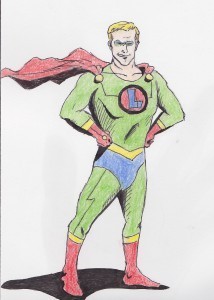
Copyright Darian Jones
This being NaNoWriMo I should probably be writing helpful posts about my own revising process… but the fact of the matter is I kind of have my hands so full with revising right now I just don’t have the time. Perhaps that sort of advice will come in handy next month, when so many people have most or large portions of brand new novels written.
In any case, today I’m just going to post some links.
First, for all of you writers out there, here’s some depressing news, although most of you probably already knew it.
Second, a wonderful letter from Sam Sykes to GrimDark fantasy you definitely need to read.
Finally, some writing advice from the talented, award-winning, indefatigable Mary Robinette Kowal.
Link Man, away!
November 3, 2014
Hardboiled Monday: Quarry
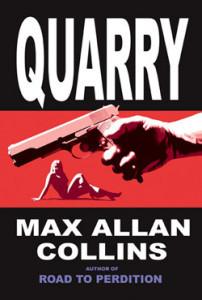 As with preceding Hardboiled Mondays, Chris Hocking and I are working our way down the master list in alphabetical order. Details and the list are here. And earlier discussions are here.
As with preceding Hardboiled Mondays, Chris Hocking and I are working our way down the master list in alphabetical order. Details and the list are here. And earlier discussions are here.
Today we’re looking at one of the book seres by famed mystery and suspense writer Max Allan Collins, Quarry.
Chris: Although Collins once wrote me that the Nate Heller series was his most significant work, I still prefer Quarry. The early novels about this dark protagonist translated the day-to-day reality of the 1970s into lucid, matter-of-fact prose in the same fashion that Gold Medal Originals often did for the 1950s.
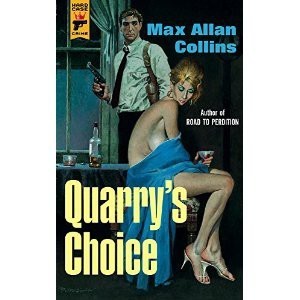 More to the point, Quarry is a top drawer anti-hero, a remorseless hitman who often finds himself pitting his lethal skills against characters more reprehensible, if ultimately not quite as dangerous, as he is. Leavened with plentiful black humor, casual sexuality, and sharp blasts of abrupt violence, these novels read with great speed and often feature endings with an extra wicked twist.
More to the point, Quarry is a top drawer anti-hero, a remorseless hitman who often finds himself pitting his lethal skills against characters more reprehensible, if ultimately not quite as dangerous, as he is. Leavened with plentiful black humor, casual sexuality, and sharp blasts of abrupt violence, these novels read with great speed and often feature endings with an extra wicked twist.
I confess a peculiar fondness for stories in which the protagonist is a dangerous, scurvy bastard pitted against characters who are even worse. Maybe it’s because my Dad took me to see Fistful of Dollars when I was seven. In any case I was pleased when Collins began producing new Quarry novels in 2006 (the first four appeared in 1976 and ’77). The eleventh Quarry novel, Quarry’s Choice, is set to appear in January, 2015, from Hard Case Crime. I predict that I will buy it (as usual), vow to save and savor it (as usual) then read it as quickly as possible at the very first opportunity (as usual).
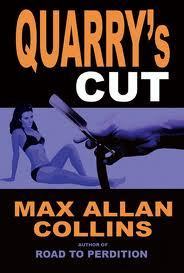 Howard: Technically my interest in Quarry pre-dates the creation of the list. Like the Westlake/Stark Parker books, if I wasn’t already reading them, Chris would have slipped them into the master list because they’re top notch. They’re actually the second set of hardboiled books I read. I’d finally gotten around to trying the Parker series, devouring it while I was laid up after a knee surgery, and I called Hocking to ask if there was anything with the same tone and of similar quality.
Howard: Technically my interest in Quarry pre-dates the creation of the list. Like the Westlake/Stark Parker books, if I wasn’t already reading them, Chris would have slipped them into the master list because they’re top notch. They’re actually the second set of hardboiled books I read. I’d finally gotten around to trying the Parker series, devouring it while I was laid up after a knee surgery, and I called Hocking to ask if there was anything with the same tone and of similar quality.
“Well,” he said, “there is one thing that’s like it in a way…” He was right. When I first started reading Collins I wrote that he was: “impressing me more and more, sort of the way Donald Westlake/Richard Stark did, in that the more I read of his work the more I come to appreciate how finely tuned the engines are in what seem, upon first glance, pretty simple vehicles. They’re not really simple at all, no more than a still life by a master painter is simply a snapshot of a bowl of fruit.”
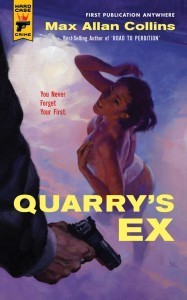 The overt sexuality and the first person narration — which allows you a good look into the mind of Collins’ protagonist — makes Quarry novels different from the Parker books, as does Quarry’s profession, but the skillful variation on the theme and the capable, compelling way that Collins interests you in what happens to a character you probably shouldn’t be rooting for has a lot in common with what Stark did with Parker.
The overt sexuality and the first person narration — which allows you a good look into the mind of Collins’ protagonist — makes Quarry novels different from the Parker books, as does Quarry’s profession, but the skillful variation on the theme and the capable, compelling way that Collins interests you in what happens to a character you probably shouldn’t be rooting for has a lot in common with what Stark did with Parker.
Odd as it may seem, despite the fact that Quarry is a hired killer you find yourself liking the guy. He tips well and sympathizes for the plight of the working man. He likes good genre books (like Leonard’s Valdez is Coming). In a lot of ways he’s an opened-minded guy and is quite relatable. Except for, you know, brutally eliminating humans without remorse. He questions sometimes, sure, but he feels no remorse.
Chris: It did occur to me that some readers might find the Quarry novels were not to their taste. Their unreconstructed, old school manly narrator may rub some the wrong way, as might the relaxed 1970s style sexuality, or Quarry’s equally matter-of-fact willingness to kill people.
The books first made their appearance in the era of “Men’s Action Adventure” novels, and sat on shelves not far from The Executioner, The Death Merchant and umpteen other lethal, masculine heroes. But while Quarry may share some of the basic attributes of these characters, his adventures bring something more to the reader, something richer and somewhat paradoxical.The best Quarry novels have a powerful noir surge.
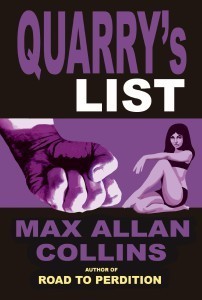 The second book, Quarry’s List, may not be the finest in the series, but it ends with a dizzyingly dark twist in which the narrator performs what I can only describe as a cruelly violent act of mercy and kindness.
The second book, Quarry’s List, may not be the finest in the series, but it ends with a dizzyingly dark twist in which the narrator performs what I can only describe as a cruelly violent act of mercy and kindness.
Given this noir element it’s striking that the books consistently feature a steady stream of black humor. Sometimes the humor is understated, sometimes in-your-face, but it gives the series a wry, self-aware sensibility.
This combination of grim noir and black humor suffuses fast-moving plots awash with violent action, sex, mystery, intrigue, and double-dealing, creating some pretty distinctive entertainment. Not for everybody, sure. But I’ll take all Collins will write.
Howard: I’m right there with you, and I’ll definitely be trying out some of his other work now as well. You mentioned earlier that the Quarry novels read with great speed and I have to concur. Collins has the ability to relentlessly pull you forward. I’ve read every one of these and I’m still trying to figure out exactly how he does it… Once you start they’re nearly impossible to put down.
In any case, for all of the reasons Chris and I cited above, I’m awarding Quarry a star, just as I’ve awarded my very favorite books/authors/series from the list. If you like this kind of noir, Quarry is a must-read.
Howard Andrew Jones's Blog
- Howard Andrew Jones's profile
- 368 followers



